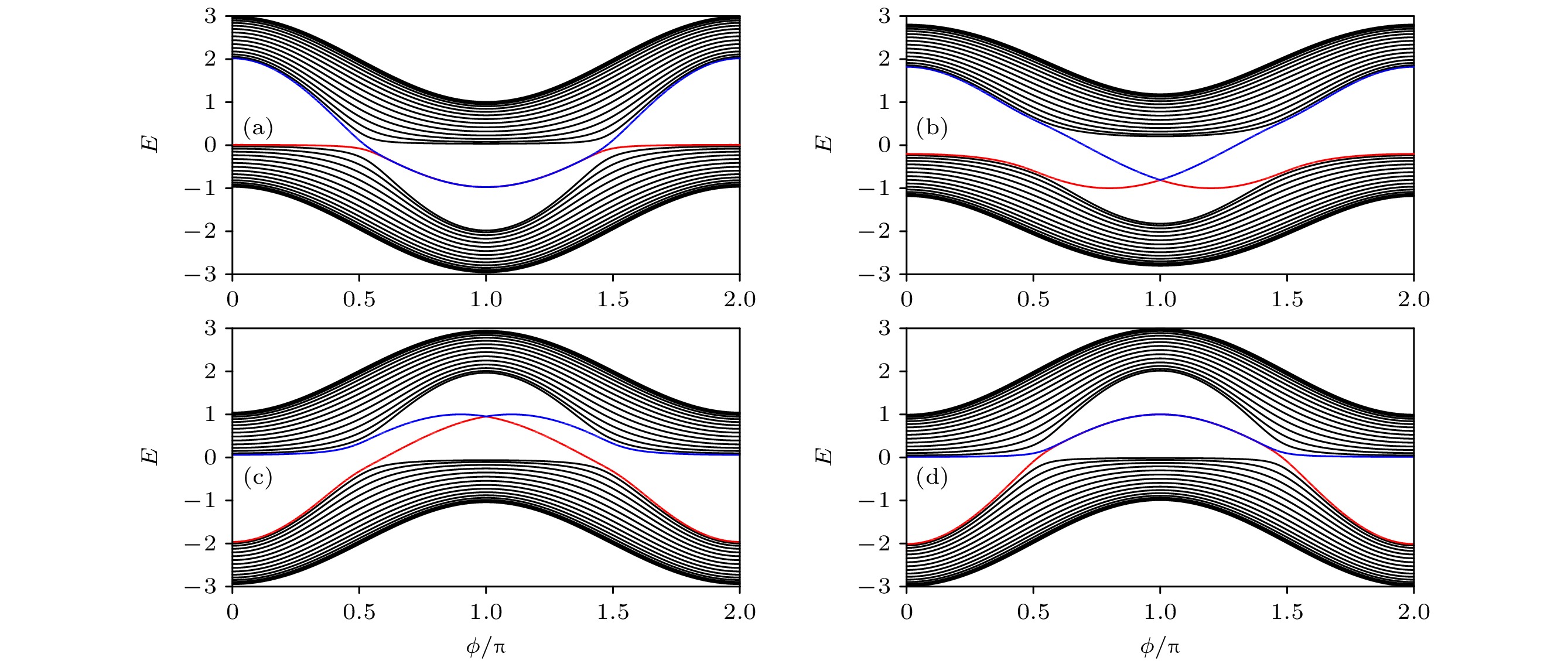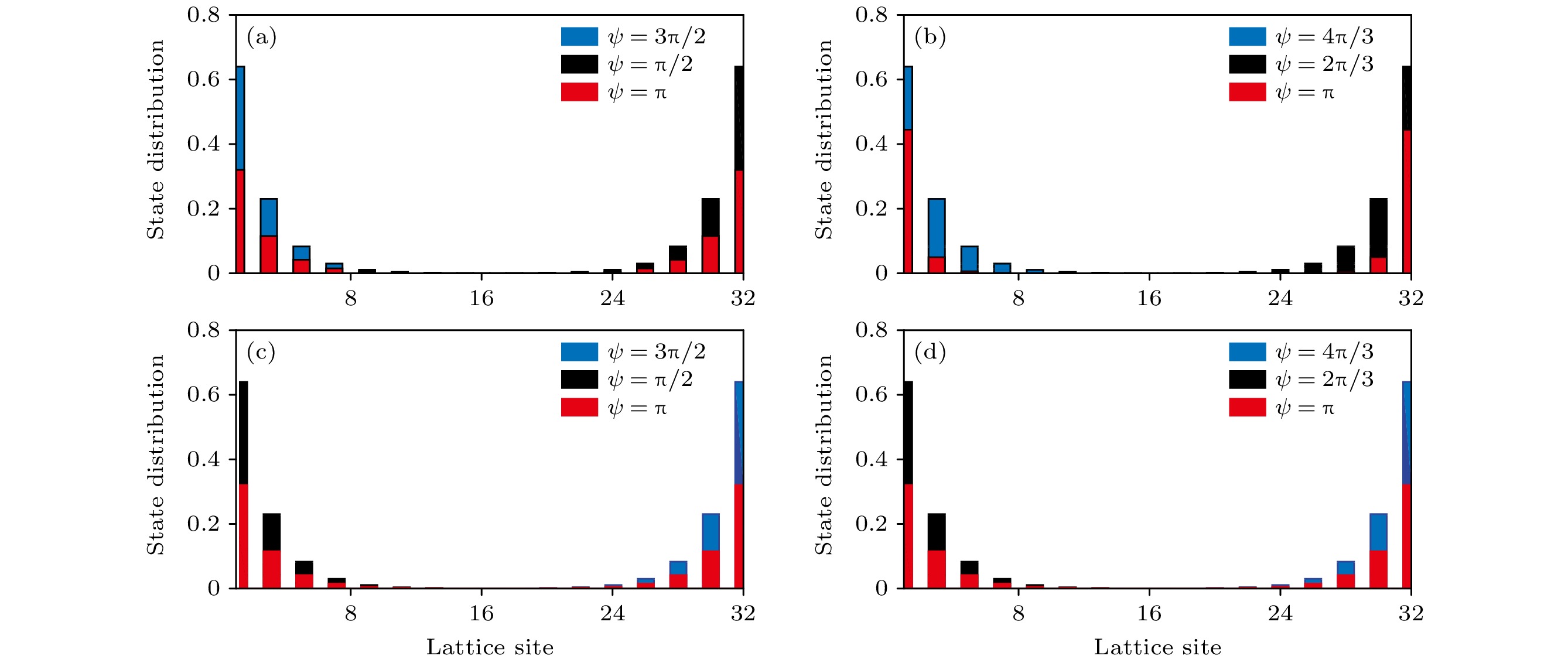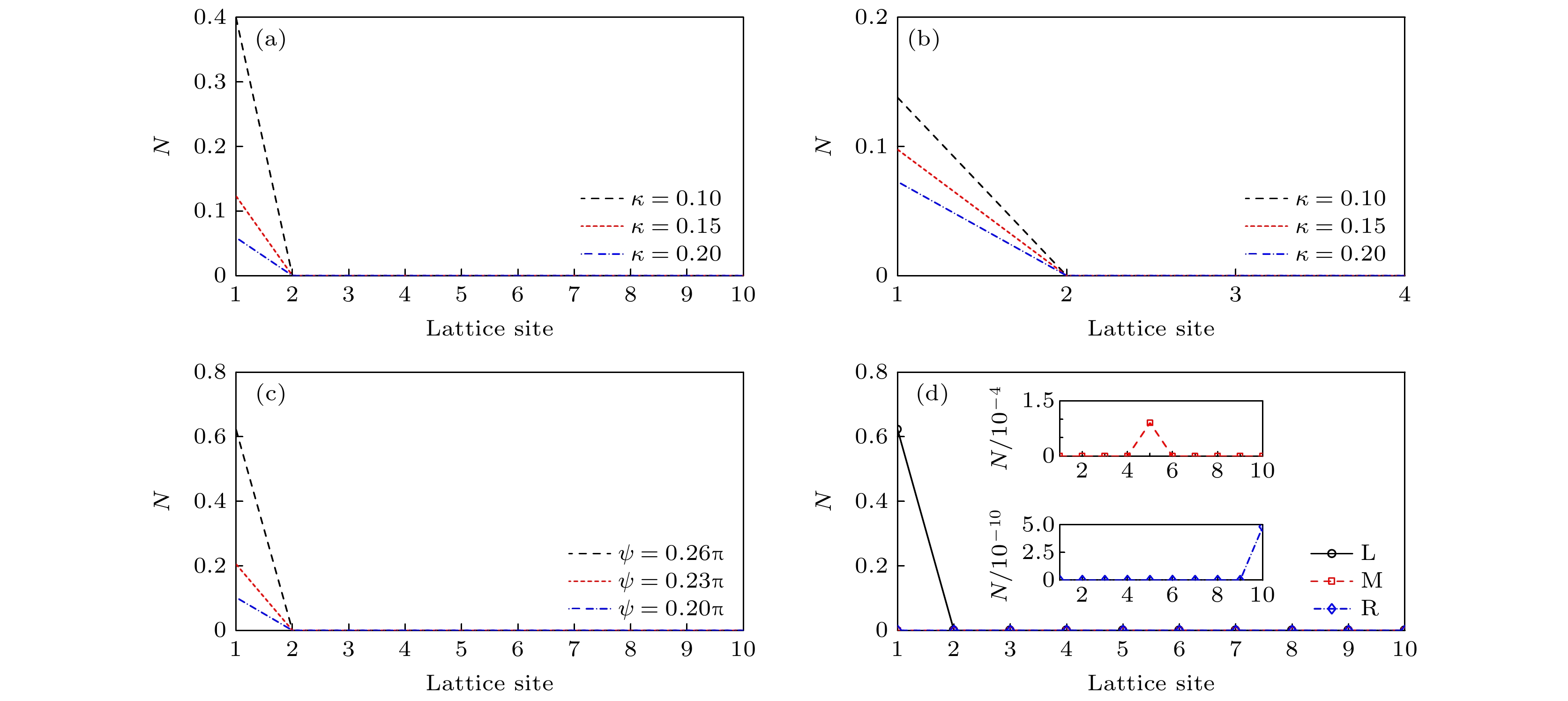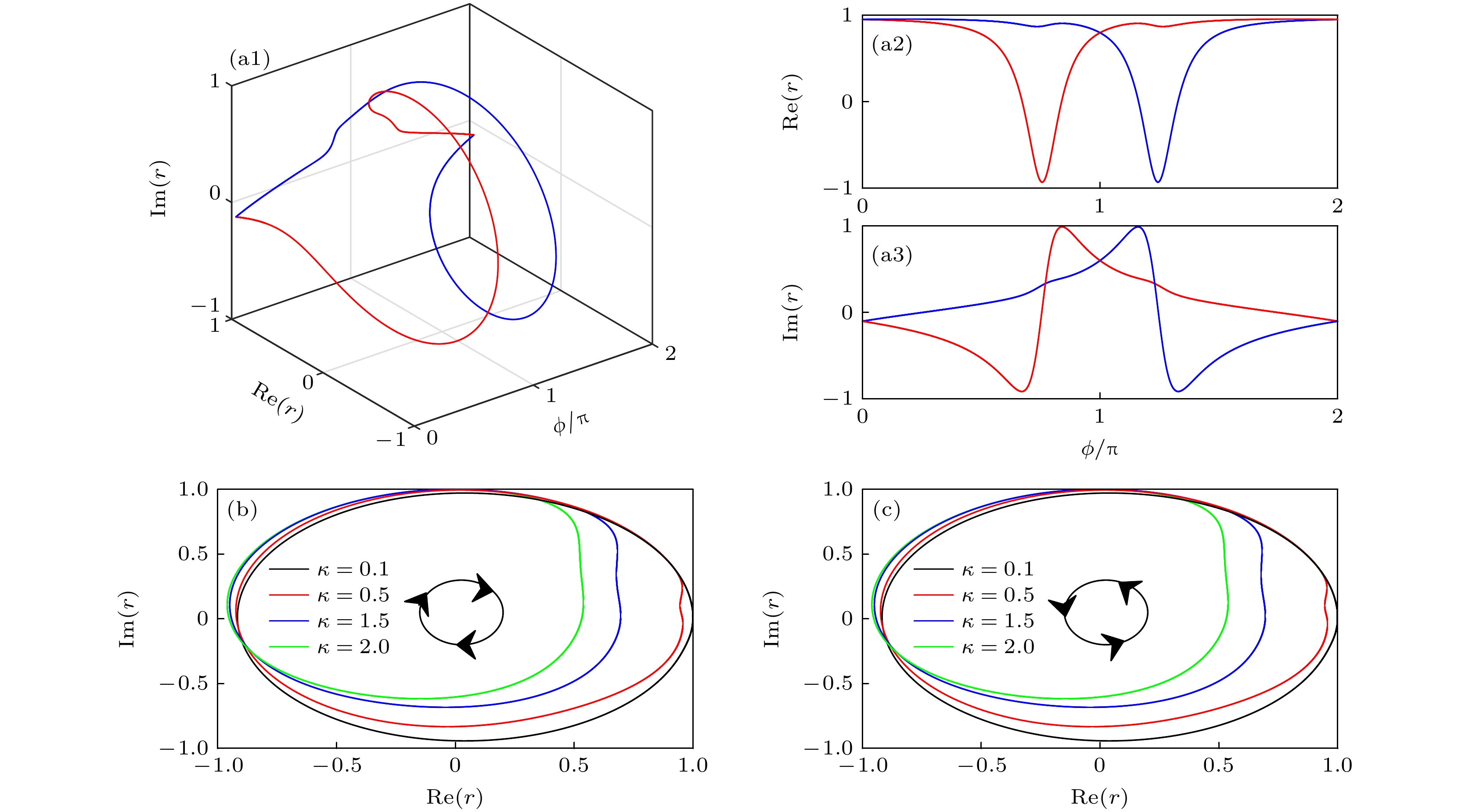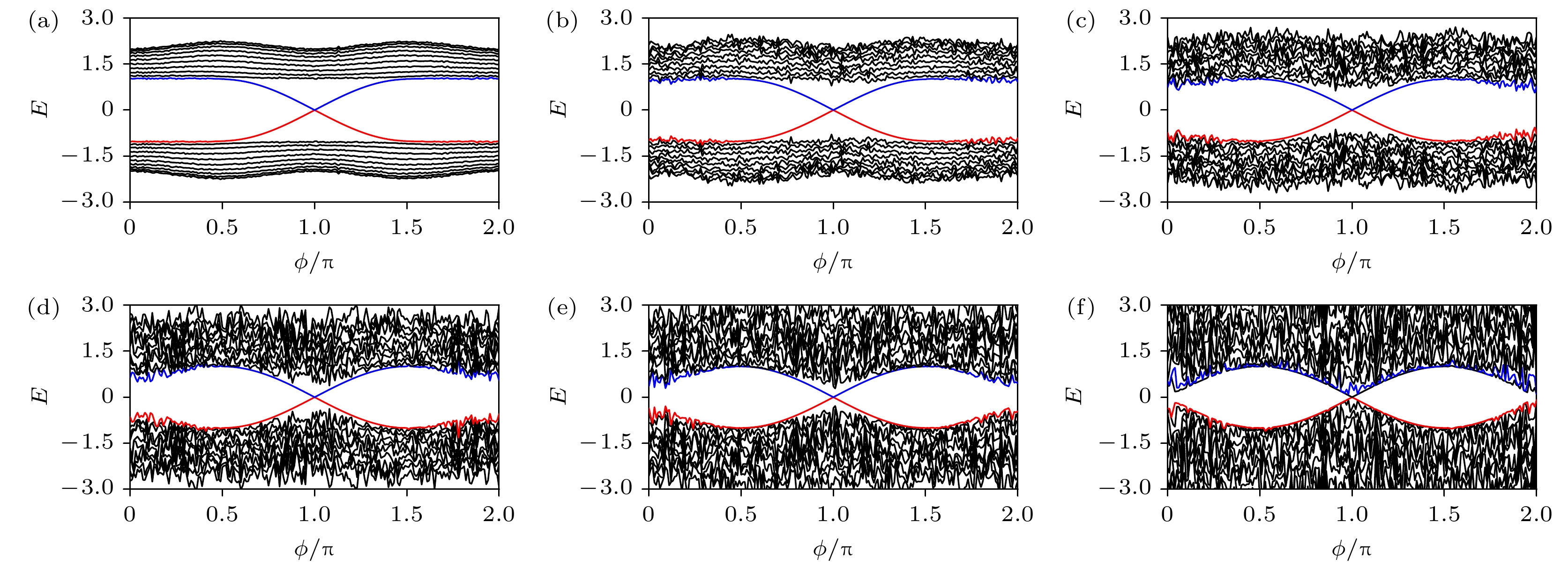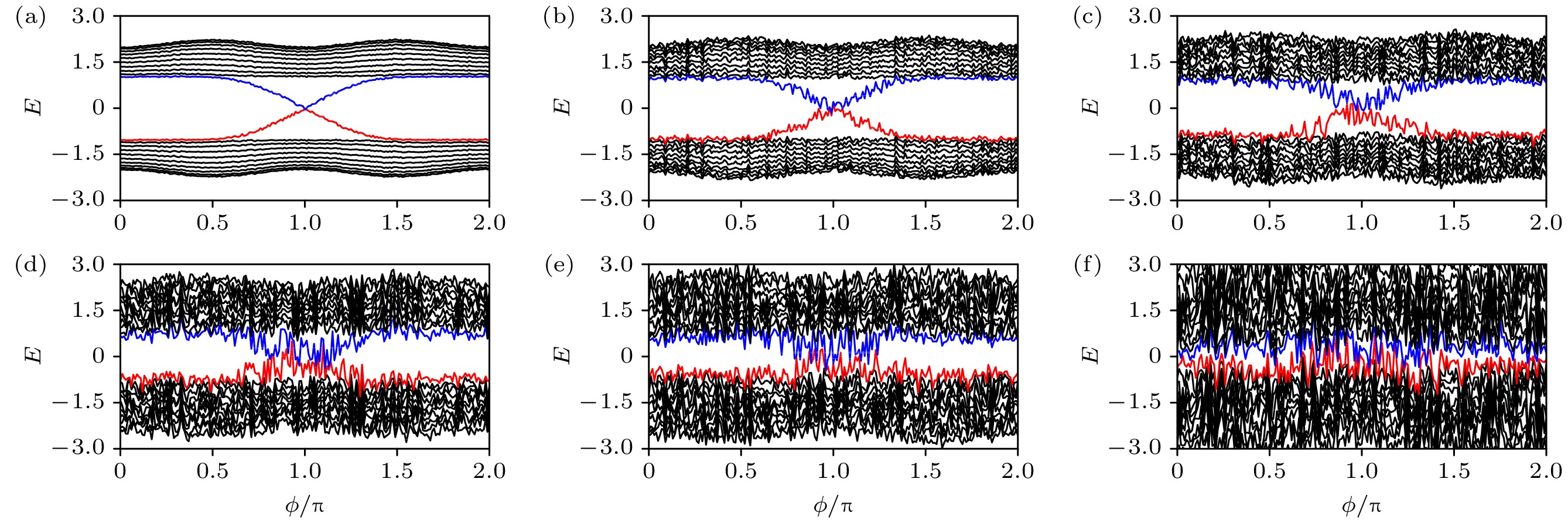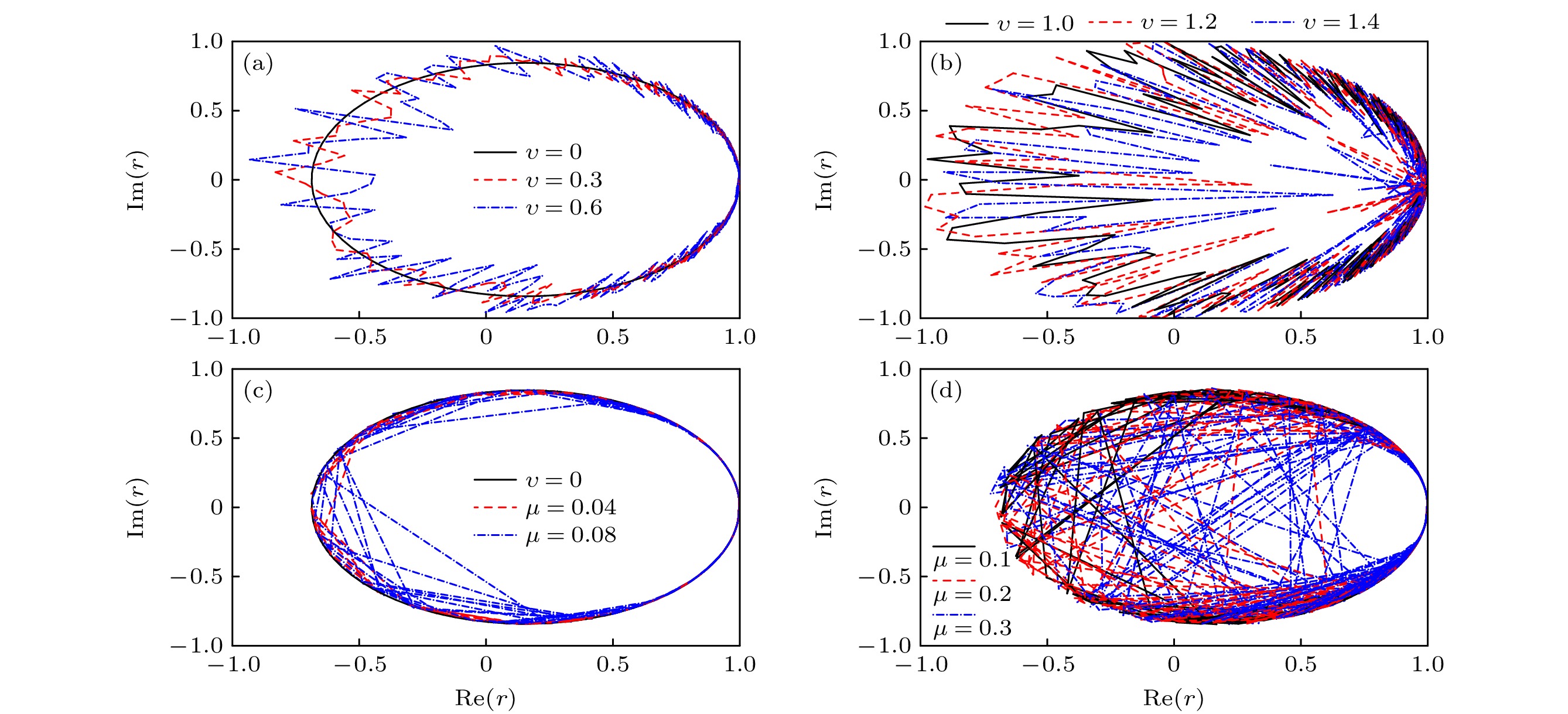-
We propose a one-dimensional lattice theory scheme based on a coupled optomechanical system consisting of multiple cavity field modes and mechanical modes, where their frequencies can be tuned. In this system, by manipulating parameters to obtain collective dynamical evolution of the system, we study topological properties and topological quantum channels in the system. Firstly, the topological insulator properties and topological quantum channels of the system are studied by modulating the periodic coupling parameters of the system and analyzing the characteristics of the energy spectrum and edge states of the system. It is found that edge state distributions can exhibit flipping processes, which can be applied to quantum information processing. Secondly, based on the scattering theory of topological insulators and the relationship between input and output, the variation characteristics of the steady-state average photon number of the cavity field and the winding number of the reflection coefficient phase are analyzed. It is found that the dissipation of the cavity field has a certain influence on the locality of the distribution of the average photon number in the lattice, and it also indirectly explains the locality of the edge states of the system, and the topological invariants are detected by the winding number. In addition, considering the effect of disordered defects on topological properties, we further analyze their effects on the energy spectrum of the system, the winding number of the reflection coefficient phase and the average photon number of the cavity field. It is found that two defects in the system cause different physical effects, and when their values are small, the edge states of the system are robust to it, which also shows that the system has the characteristics of topological protection. However, when disorder and perturbation are larger than the energy gap, the topological properties of the system will be annihilated, so that the edge states will be indistinguishable, and the topological invariants will change at the same time. The research results of this system can be generalized to other types of models and can be applied to quantum communication and quantum information processing, which will have certain constructive suggestions for the development of future quantum technology.
-
Keywords:
- quantum optics /
- optomechanics /
- topological insulators /
- quantum states
[1] Braginskii V B and Manukin A B 1967 Sov. Phys. JETP 25 653
[2] Aspelmeyer M, Kippenberg T J, Marquardt F 2014 Rev. Mod. Phys. 86 1391
 Google Scholar
Google Scholar
[3] Liu Y L, Wang C, Zhang J, Liu Y X 2018 Chin. Phys. B 27 024204
 Google Scholar
Google Scholar
[4] Weis S, Riviere R, Deleglise S, Gavartin E, Arcizet O, Schliesser A, Kippenberg T J 2010 Science 330 1520
 Google Scholar
Google Scholar
[5] You J Q, Nori F 2011 Nature 474 589
 Google Scholar
Google Scholar
[6] Martin I, Shnirman A, Lin T, Zoller P 2004 Phys. Rev. B 69 125339
 Google Scholar
Google Scholar
[7] Xiao Y, Yu Y F, Zhang Z M 2014 Opt. Express 22 17979
 Google Scholar
Google Scholar
[8] Wang Y P, Zhang Z C, Yu Y F, Zhang Z M 2019 Laser Phys. Lett. 16 015205
 Google Scholar
Google Scholar
[9] Wei W Y, Yu Y F, Zhang Z M 2018 Chin. Phys. B 27 034204
 Google Scholar
Google Scholar
[10] Huang S M, Agarwal G S 2010 Phys. Rev. A 81 033830
 Google Scholar
Google Scholar
[11] Zhang Z C, Wang Y P, Yu Y F, Zhang Z M 2019 Ann.Phys. 531 1800461
 Google Scholar
Google Scholar
[12] Wang K, Yu Y F, Zhang Z M 2019 Phys. Rev. A 100 053832
 Google Scholar
Google Scholar
[13] Li J, Yu R, Ding C, Wu Y 2014 Opt. Express 22 15024
 Google Scholar
Google Scholar
[14] Devoret M H, Schoelkopf R J 2013 Science 339 1169
 Google Scholar
Google Scholar
[15] Wang Y P, Zhang Z C, Yu Y F, Zhang Z M 2018 J. Phys. B: At. Mol. Opt. Phys. 51 175504
 Google Scholar
Google Scholar
[16] Massel F, Heikkil T T, Pirkkalainen J M, Cho S U, Saloniemi H, Hakonen P J, Sillanpää M A 2011 Nature 480 351
 Google Scholar
Google Scholar
[17] Wang Y P, Zhang Z C, Yu Y F, Zhang Z M 2019 Chin. Phys. B 28 014202
 Google Scholar
Google Scholar
[18] Teufel J D, Li D, Allman M S, Cicak K, Sirois A J, Whittaker J D, Simmonds R W 2011 Nature 471 204
 Google Scholar
Google Scholar
[19] Qi X L, Zhang S C 2011 Rev. Mod. Phys. 83 1057
 Google Scholar
Google Scholar
[20] Hasan M Z, Kane C L 2010 Rev. Mod. Phys. 82 3045
 Google Scholar
Google Scholar
[21] Bansil A, Lin H, Das T 2016 Rev. Mod. Phys. 88 021004
 Google Scholar
Google Scholar
[22] Chiu C K, Teo J C Y, Schnyder A P, Ryu S 2016 Rev. Mod. Phys. 88 035005
 Google Scholar
Google Scholar
[23] Xu Z, Zhang Y, Chen S 2017 Phys. Rev. A 96 013606
 Google Scholar
Google Scholar
[24] Li L, Xu Z, Chen S 2014 Phys. Rev. B 89 085111
 Google Scholar
Google Scholar
[25] Li L, Chen S 2015 Phys. Rev. B 92 085118
 Google Scholar
Google Scholar
[26] Mei F, Zhu S L, Zhang Z M, Oh C H, Goldman N 2012 Phys. Rev. A 85 013638
 Google Scholar
Google Scholar
[27] Xu Z, Zhang R, Chen S, Fu L, Zhang Y 2020 Phys. Rev. A 101 013635
 Google Scholar
Google Scholar
[28] Wray L A, Xu V, Xia Y, Hsieh D, Fedorov A V, SanHor Y, Cava R J, Bansil A, Lin H, Hasan M Z 2011 Nat. Phys. 7 32
 Google Scholar
Google Scholar
[29] Malki M, Uhrig G S 2017 Phys. Rev. B 95 235118
 Google Scholar
Google Scholar
[30] Berg E, Dalla Torre E G, Giamarchi T, Altman E 2008 Phys. Rev. B 77 245119
 Google Scholar
Google Scholar
[31] Chitov G Y 2018 Phys. Rev. B 97 085131
 Google Scholar
Google Scholar
[32] Agrapidis C E, van den Brink J, Nishimoto S 2019 Phys. Rev. B 99 224418
 Google Scholar
Google Scholar
[33] Feng X Y, Zhang G M, Xiang T 2007 Phys. Rev. Lett 98 087204
 Google Scholar
Google Scholar
[34] Roque T F, Peano V, Yevtushenko O M, Marquardt F 2017 New J. Phys 19 013006
 Google Scholar
Google Scholar
[35] Wan L L, Lü X Y, Gao J H, Wu Y 2017 Opt. Express 25 017364
 Google Scholar
Google Scholar
[36] Qi L, Yan Y, Wang G L, Zhang S, Wang H F 2019 Phys. Rev. B 100 062323
 Google Scholar
Google Scholar
[37] Xu X W, Zhao Y J, Wang H, Chen A X, Liu Y X 2022 Front. Phys. 10 3389
[38] Mei F, Xue Z Y, Zhang D W, Tian L, Lee C, Zhu S L 2016 Quantum Sci. Technol. 1 015006
 Google Scholar
Google Scholar
[39] Walls D F, Milburn G J 2008 Quantum Optics (Berlin: Springer) pp127–138
[40] Clerk A A, Devoret M H, Girvin S M, Marquardt F, Schoelkopf R J 2010 Rev. Mod. Phys. 82 1155
 Google Scholar
Google Scholar
-
图 1 一维(1D)腔光力耦合晶格系统模型图,
$ a_n $ 和$ b_n $ 分别表示腔场和机械振子的模式, 其中包含$ N+1 $ 个腔模式和$ N $ 个机械模式Fig. 1. Schematic of the 1D optomechanical coupling lattice system,
$ a_n $ and$ b_n $ represent the modes of the cavity field and the mechanical oscillator, respectively, and including$ N+1 $ cavity modes and$ N $ mechanical modes.图 2 系统能谱E与参数
$ \phi $ 的物理图像 (a)$ M_{1} = M_{2} = 0 $ ; (b)$ M_{1} = 0, M_{2} = 0.1 $ . 参数$ \phi $ 取值范围为(0,$2\text{π}$ ),$N = 15$ Fig. 2. The energy spectrum E of the system vs the parameter
$ \phi $ : (a)$ M_{1} = M_{2} = 0 $ ; (b)$ M_{1} = 0, M_{2} = 0.1 $ . The range of parameter$ \phi $ is (0,$2\text{π}$ ),$ N = 15 $ 图 3 系统能谱E与参数
$ \phi $ 的物理图像 (a)$ \psi = 0 $ ; (b)$ \psi = 0.1\pi $ ; (c)$ \psi = 0.9\pi $ ; (d)$ \psi = \pi $ . 参数$ \phi $ 取值范围为($0, 2\pi $ ),$N = 15$ Fig. 3. The energy spectrum E of the system vs the parameter
$ \phi $ : (a)$ \psi=0 $ ; (b)$ \psi=0.1\pi $ ; (c)$ \psi=0.9\pi $ ; (d)$ \psi=\pi $ . The range of parameter$ \phi $ is (0,$ 2\pi $ ),$ N = 15 $ 图 4 边缘态分布与晶格数的物理图像 (a), (c)
$ \phi = 2\pi/3 $ ,$ \psi = 3\pi/2, \pi/2, \pi $ ; (b), (d)$ \phi = \pi/3 $ ,$ \psi = 4\pi/3, 2\pi/3, \pi $ Fig. 4. The state distribution vs the lattice number: (a), (c)
$ \phi = 2\pi/3 $ ,$ \psi = 3\pi/2, \pi/2, \pi $ ; (b), (d)$ \phi = \pi/3 $ ,$ \psi = 4\pi/3, 2\pi/3, \pi $ 图 5 沿晶格方向腔场稳态的平均光子数N与晶格数的物理图像 (a)晶格数为10, 驱动频率为
$ \varDelta _{a, n} = 0.25 t $ ,$ \psi = 0.25\pi $ ; (b)晶格数为4, 驱动频率是$ \varDelta _{a, n} = - 0.01 t $ ,$ \psi = 0.25\pi $ , 黑色虚线$ \kappa = 0.1 $ , 红色点线$ \kappa = 0.15 $ , 蓝色点虚线$ \kappa = 0.2 $ ; (c)$ \psi = $ $ 0.2\pi, 0.23\pi, 0.26\pi $ ; (d)在腔的最左边(黑色线圆)、中间(红色虚线正方形)和最右边(蓝色点虚线菱形)驱动晶格.其他参数为$ \varOmega _{1 a} = 0.1 t $ ,$ \phi = 0.8\pi $ Fig. 5. The average photon number N vs the lattice number: (a) The lattice size 10,
$ \varDelta _{a, n} = 0.25 t $ ,$ \psi = 0.25\pi $ ; (b) the lattice size 4,$ \varDelta _{a, n} = - 0.01 t $ ,$ \psi = 0.25\pi $ , black dotted line$ \kappa = 0.1 $ , the red dotted line$ \kappa = 0.15 $ , the blue dotted line$ \kappa = 0.2 $ ; (c)$ \psi = 0.2\pi, 0.23\pi, 0.26\pi $ ; (d) lattice site driven at the far left (black circles), middle (red dashed squares) and rightmost (blue dotted diamonds). Other parameters are Ω1a = 0.1t and ϕ=0.8π图 6 反射系数相的环绕数随参数
$ \phi $ 的变化 (a1), (a2), (a3)蓝色线条为$ \psi = \pi/2 $ , 红色线条为$ \psi = - \pi/2 $ ; (b)$\psi = $ $ \pi/2$ ,$ \kappa = 0.1, 0.5, 1.5, 2 $ ; (c)$ \psi = - \pi/2 $ ,$ \kappa=0.1, 0.5, 1.5, 2 $ . 其他参数为$\varOmega _{1 a} = 0.75 t$ , 晶格数为10Fig. 6. The winding number of the reflection coefficient phase varies with parameter
$ \phi $ : (a1), (a2), (a3) The blue line is$ \psi = \pi/2 $ , the red line is$ \psi = - \pi/2 $ ; (b)$ \psi = \pi/2 $ ,$ \kappa=0.1, 0.5, 1.5, 2 $ ; (c)$ \psi = - \pi/2 $ ,$ \kappa = 0.1, 0.5, 1.5, 2 $ . Other parameters are$\varOmega _{1 a} = 0.75 t$ and lattice size 10.图 7 最近邻相互作用之间的无序与系统能谱的物理图像 (a)
$ \upsilon = 0.1 $ ; (b)$ \upsilon = 0.5 $ ; (c)$ \upsilon = 1 $ ; (d)$ \upsilon = 1.5 $ ; (e)$ \upsilon = 2 $ ; (f)$ \upsilon = 3 $ . 其他参数为$ \psi = \pi/2 $ , 晶格数为10Fig. 7. The effects of the disorder added into the nearest neighbor interaction on the energy spectra (a)
$ \upsilon = 0.1 $ ; (b)$ \upsilon = 0.5 $ ; (c)$ \upsilon = 1 $ ; (d)$ \upsilon = 1.5 $ ; (e)$ \upsilon = 2 $ ; (f)$ \upsilon = 3 $ . Other parameters are$ \psi = \pi/2 $ and lattice size 10.图 8 在位无序与系统能谱的物理图像 (a)
$ \mu = 0.1 $ ; (b)$ \mu = 0.5 $ ; (c)$ \mu = 1 $ ; (d)$ \mu = 1.5 $ ; (e)$ \mu = 2 $ ; (f)$ \mu = 3 $ . 其他参数为$ \psi = \pi/2 $ , 晶格数为10Fig. 8. The effects of the disorder added into the on-site potential energy on the energy spectra: (a)
$ \mu = 0.1 $ ; (b)$ \mu = 0.5 $ , (c)$ \mu = 1 $ ; (d)$ \mu = 1.5 $ ; (e)$ \mu = 2 $ , (f)$ \mu = 3 $ . Other parameters are$ \psi = \pi/2 $ and lattice size 10.图 10 反射系数相的环绕数与无序缺陷的物理图像 (a)
$ \upsilon = 0, 0.3, 0.6 $ ; (b)$ \upsilon = 1, 1.2, 1.4 $ ; (c)$ \mu = 0, 0.04, 0.08 $ ; (d)$\mu = 0.1, $ $ 0.2, 0.3$ . 其他参数为$ \psi = \pi/2 $ ,$ \kappa = 0.1 $ , 晶格数为10Fig. 10. The winding number of the reflection coefficient phase varies with the disorder: (a)
$ \upsilon = 0, 0.3, 0.6 $ ; (b)$ \upsilon = 1, 1.2, 1.4 $ ; (c)$ \mu = 0, 0.04, 0.08 $ ; (d)$ \mu = 0.1, 0.2, 0.3 $ . Other parameters are$ \psi = \pi/2 $ ,$ \kappa = 0.1 $ and lattice size 10.图 11 沿晶格方向腔场稳态的平均光子数与缺陷强度
$ \mu $ ,$ \upsilon $ 和晶格数的物理图像 (a)$ \upsilon = 0, 1, 2, 3 $ ; (b)$ \mu = 0, 1, 2, 3 $ . 其他参数为$\varOmega _{1 a} = 0.1 t$ ,$ \phi = 0.8\pi $ ,$\varDelta _{a, n} = - 0.5 t$ ,$ \kappa = 0.1 $ , 晶格数为10Fig. 11. The average photon number
$ N $ varies with the defect intensity$ \mu $ ,$ \upsilon $ and lattice number, respectively: (a)$ \upsilon = $ $ 0, 1, 2, 3 $ ; (b)$ \mu = 0, 1, 2, 3 $ . Other parameters are$\varOmega _{1 a} = 0.1 t$ ,$ \phi = 0.8\pi $ ,$\varDelta _{a, n} = - 0.5 t$ ,$ \kappa = 0.1 $ and lattice size 10. -
[1] Braginskii V B and Manukin A B 1967 Sov. Phys. JETP 25 653
[2] Aspelmeyer M, Kippenberg T J, Marquardt F 2014 Rev. Mod. Phys. 86 1391
 Google Scholar
Google Scholar
[3] Liu Y L, Wang C, Zhang J, Liu Y X 2018 Chin. Phys. B 27 024204
 Google Scholar
Google Scholar
[4] Weis S, Riviere R, Deleglise S, Gavartin E, Arcizet O, Schliesser A, Kippenberg T J 2010 Science 330 1520
 Google Scholar
Google Scholar
[5] You J Q, Nori F 2011 Nature 474 589
 Google Scholar
Google Scholar
[6] Martin I, Shnirman A, Lin T, Zoller P 2004 Phys. Rev. B 69 125339
 Google Scholar
Google Scholar
[7] Xiao Y, Yu Y F, Zhang Z M 2014 Opt. Express 22 17979
 Google Scholar
Google Scholar
[8] Wang Y P, Zhang Z C, Yu Y F, Zhang Z M 2019 Laser Phys. Lett. 16 015205
 Google Scholar
Google Scholar
[9] Wei W Y, Yu Y F, Zhang Z M 2018 Chin. Phys. B 27 034204
 Google Scholar
Google Scholar
[10] Huang S M, Agarwal G S 2010 Phys. Rev. A 81 033830
 Google Scholar
Google Scholar
[11] Zhang Z C, Wang Y P, Yu Y F, Zhang Z M 2019 Ann.Phys. 531 1800461
 Google Scholar
Google Scholar
[12] Wang K, Yu Y F, Zhang Z M 2019 Phys. Rev. A 100 053832
 Google Scholar
Google Scholar
[13] Li J, Yu R, Ding C, Wu Y 2014 Opt. Express 22 15024
 Google Scholar
Google Scholar
[14] Devoret M H, Schoelkopf R J 2013 Science 339 1169
 Google Scholar
Google Scholar
[15] Wang Y P, Zhang Z C, Yu Y F, Zhang Z M 2018 J. Phys. B: At. Mol. Opt. Phys. 51 175504
 Google Scholar
Google Scholar
[16] Massel F, Heikkil T T, Pirkkalainen J M, Cho S U, Saloniemi H, Hakonen P J, Sillanpää M A 2011 Nature 480 351
 Google Scholar
Google Scholar
[17] Wang Y P, Zhang Z C, Yu Y F, Zhang Z M 2019 Chin. Phys. B 28 014202
 Google Scholar
Google Scholar
[18] Teufel J D, Li D, Allman M S, Cicak K, Sirois A J, Whittaker J D, Simmonds R W 2011 Nature 471 204
 Google Scholar
Google Scholar
[19] Qi X L, Zhang S C 2011 Rev. Mod. Phys. 83 1057
 Google Scholar
Google Scholar
[20] Hasan M Z, Kane C L 2010 Rev. Mod. Phys. 82 3045
 Google Scholar
Google Scholar
[21] Bansil A, Lin H, Das T 2016 Rev. Mod. Phys. 88 021004
 Google Scholar
Google Scholar
[22] Chiu C K, Teo J C Y, Schnyder A P, Ryu S 2016 Rev. Mod. Phys. 88 035005
 Google Scholar
Google Scholar
[23] Xu Z, Zhang Y, Chen S 2017 Phys. Rev. A 96 013606
 Google Scholar
Google Scholar
[24] Li L, Xu Z, Chen S 2014 Phys. Rev. B 89 085111
 Google Scholar
Google Scholar
[25] Li L, Chen S 2015 Phys. Rev. B 92 085118
 Google Scholar
Google Scholar
[26] Mei F, Zhu S L, Zhang Z M, Oh C H, Goldman N 2012 Phys. Rev. A 85 013638
 Google Scholar
Google Scholar
[27] Xu Z, Zhang R, Chen S, Fu L, Zhang Y 2020 Phys. Rev. A 101 013635
 Google Scholar
Google Scholar
[28] Wray L A, Xu V, Xia Y, Hsieh D, Fedorov A V, SanHor Y, Cava R J, Bansil A, Lin H, Hasan M Z 2011 Nat. Phys. 7 32
 Google Scholar
Google Scholar
[29] Malki M, Uhrig G S 2017 Phys. Rev. B 95 235118
 Google Scholar
Google Scholar
[30] Berg E, Dalla Torre E G, Giamarchi T, Altman E 2008 Phys. Rev. B 77 245119
 Google Scholar
Google Scholar
[31] Chitov G Y 2018 Phys. Rev. B 97 085131
 Google Scholar
Google Scholar
[32] Agrapidis C E, van den Brink J, Nishimoto S 2019 Phys. Rev. B 99 224418
 Google Scholar
Google Scholar
[33] Feng X Y, Zhang G M, Xiang T 2007 Phys. Rev. Lett 98 087204
 Google Scholar
Google Scholar
[34] Roque T F, Peano V, Yevtushenko O M, Marquardt F 2017 New J. Phys 19 013006
 Google Scholar
Google Scholar
[35] Wan L L, Lü X Y, Gao J H, Wu Y 2017 Opt. Express 25 017364
 Google Scholar
Google Scholar
[36] Qi L, Yan Y, Wang G L, Zhang S, Wang H F 2019 Phys. Rev. B 100 062323
 Google Scholar
Google Scholar
[37] Xu X W, Zhao Y J, Wang H, Chen A X, Liu Y X 2022 Front. Phys. 10 3389
[38] Mei F, Xue Z Y, Zhang D W, Tian L, Lee C, Zhu S L 2016 Quantum Sci. Technol. 1 015006
 Google Scholar
Google Scholar
[39] Walls D F, Milburn G J 2008 Quantum Optics (Berlin: Springer) pp127–138
[40] Clerk A A, Devoret M H, Girvin S M, Marquardt F, Schoelkopf R J 2010 Rev. Mod. Phys. 82 1155
 Google Scholar
Google Scholar
计量
- 文章访问数: 6033
- PDF下载量: 96
- 被引次数: 0






















 下载:
下载:













